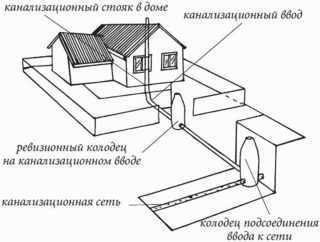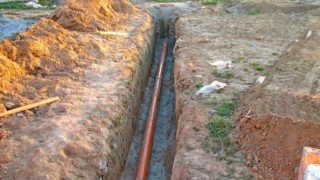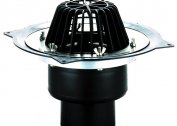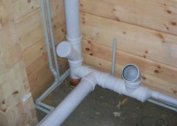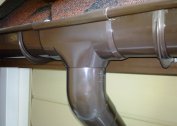An external sewage system is required in private and multi-storey buildings, however in the first case it is easier to lay it yourself. It is important to pay attention to the characteristics of the pipes and the basic rules for installing the system.
Current requirements for the laying of the external pipeline
The entire sewerage system of a private house is divided into internal and external. Pipes laid in the building provide the collection of drains from household appliances, sinks, toilets and baths, feeding them into a common riser. A single pipe is displayed on the street where the outer part of the sewage system begins. It includes a pipeline through which liquid waste is sent to a treatment plant.
You can get rid of sewage in the following ways:
- Connecting an external sewage system to a centralized system. It is enough to lay a pipeline and equip a well.
- Arrangement of an individual cesspool or septic tank (an essential structural element). In this case, you will need to install a local cleaning system.
According to sanitary standards, wastewater must be disposed of in such a way as not to contaminate the aquifers of the surrounding area.
Individual ways to cleanse sewage:
- Cesspool. The inconvenience of the solution is offset by its cheapness.
- Septic tank - to clean it you will need to regularly call the sewer.
- Double chamber tank with double cleaning. Heavy fractions settle in the first tank, additional filtering takes place in the second, after which water is discharged into the ground.
- Biological treatment station. Sewage decomposes under the influence of certain microorganisms.
If funds are limited, it is worth choosing a cesspool. With a sufficient budget, you can install a biological treatment plant.
Before laying the external sewage system, a project is prepared that meets the requirements of the codes of rules “Sewerage. External networks ... "(SP 32.13330.2012) and" Residential single-family houses ... "(SP 55.13330.2011). These documents replaced the SNiPs of the same name.
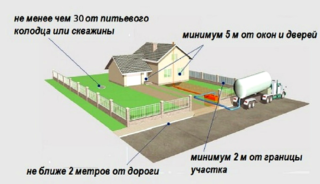 When developing sewage, the following factors are taken into account:
When developing sewage, the following factors are taken into account:
- terrain relief;
- soil characteristics;
- number of people living in the cottage;
- general climatic conditions;
- distance to clean water sources;
- the ability to connect to a central sewage system or to call the scavengers.
Sewerage of a private house operates on the principle of gravity. Installation of horizontal sections of the pipeline outside the cottage must be made with a bias towards the cleaning system. The slope should not be too large, since solid fractions may form at the entrance to the sump. The optimal angle is selected based on the diameter of the pipes:
- D500 mm - the slope should be 30 mm / linear meter.
- D1000-1100 mm - 20 mm / m.
- D1600 mm - 8 mm / m.
Mistakes in creating an outdoor sewage project increase the risk of regular clogging and poisoning of drinking water sources.
Pipe selection
Cast iron and asbestos cement have a large weight, so it is difficult to lay sewers from such pipes on their own. Polyvinyl chloride, a lightweight, convenient and non-toxic material, is very popular in the construction of an internal sewage system. However, it is not suitable for the outside - during severe frosts, the risk of cracking the walls increases.
Polypropylene has the following advantages:
- high resistance to low temperatures;
- chemical inertness;
- low weight of products;
- high mechanical strength;
- lack of corrosion;
- long service life;
- low roughness coefficient.
Polyethylene pipes have a significant advantage - they do not burst even when completely frozen. In addition, these products withstand the temperature of effluents up to 95 degrees and are resistant to aggressive chemicals. The life of plastic products is 40 years or more.
Features of the choice of pipes:
- Polypropylene products should be smooth.
- When choosing polyethylene, it is better to purchase corrugated elements. They are better suited for the construction of an underground highway, since they cope well with high mechanical pressure (for example, if they are laid under a track made of asphalt).
Plastic products are easier to install, however, when choosing them, it is necessary to take into account operating conditions: the depth of the location, the presence of a travel zone above the pipes.
Design and preparatory work
A project is a mandatory document required when installing a sewage system. It should be included in the plan of the house as a whole. If you have a ready-made version adapted to a specific climate zone, you can cook tools, look for materials and get to work. If the project is created independently, it is better to show the result of planning to a specialist.
The device of external sewage networks is carried out in accordance with the documentation, taking into account:
- soil freezing level;
- groundwater depth - the installation location is chosen so that the wastewater cannot get into the aquifers, fill the foundation or basement of the house;
- the possibility of access to the sewer system;
- septic tank volume - must correspond to the number of permanent residents, for 3 people a tank of 4 m3 is enough;
- location of manholes.
When creating an external drainage network, it is important to consider the location of storm sewers.
Mounting Features
Technology for laying an external sewer network:
- Preparation of the pit. They dig a trench with the calculation of the position of the pipes, at which they would be 50 cm below the level of freezing of the soil (for the southern regions - 1.5-2 m, for the northern 3-3.5 m). For pipes with a diameter of 110 mm, a trench 60 cm wide is dug. The bottom of the ditch must be flattened and compacted. A sand layer of 10 cm high is formed on top. At the place where the pipe enters the septic tank or collector, a site is created with a width of 2 m and a length of 1 m.
- Pipe laying. Having completed the excavation of the pit, pipes are laid along its length without trimming. At the right points fit tees, crosses, revision. Assembly begins from a local septic tank. Before connecting the pipe ends, lubricate with silicone sealant. If you need to create turns, it is better to use angles of 45 degrees. In these places, it is worth installing a well with a revision.
- Warming. When installing an external sewage system, sometimes it is necessary to additionally protect the pipes from frost. If the trench is dug of sufficient depth, there is no need for this, but in regions with cold winters it is worth reinsuring. As the insulation material, polystyrene, polyurethane foam, heat-insulating paint, basalt fiber or glass wool are used.
- Backfilling. At this stage, it is imperative to use the soil that was selected from the trench. To prevent damage to the pipe, stones, hard clods and debris must be removed from the ground. It is better to use sand, at least to the level of the upper edge of the product. To compensate for the shrinkage of the earth over the trench, you need to make a small tubercle. If electrical equipment is installed in the treatment plant, a shielded cable must be laid in the ditch before backfilling.
You can perform each of these steps yourself. Before work, it is better to consult a specialist.
Common mistakes
To install the external sewage system of high quality and in a short time possible when avoiding the following errors:
- Savings on materials. The difference in cost with cheap counterparts may be less than system repair.
- Installation of external sewage pipes in a short time. Pipeline sections must be carefully measured and carefully cut. Tilt angles must be created in strict accordance with the project.
- Insufficient drainage pipe installation. If they become clogged or have a low throughput, fluid stagnation will occur.
Prices per meter of work on laying an external sewage system start from 270 rubles (when installing pressure-free PVC systems with a diameter of 110 mm). With a pipe size of 500 mm, prices increase to 800 rubles.
